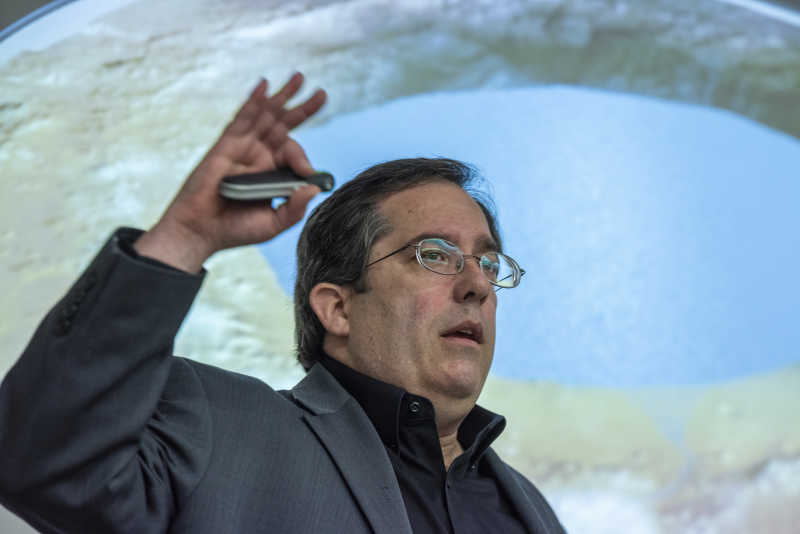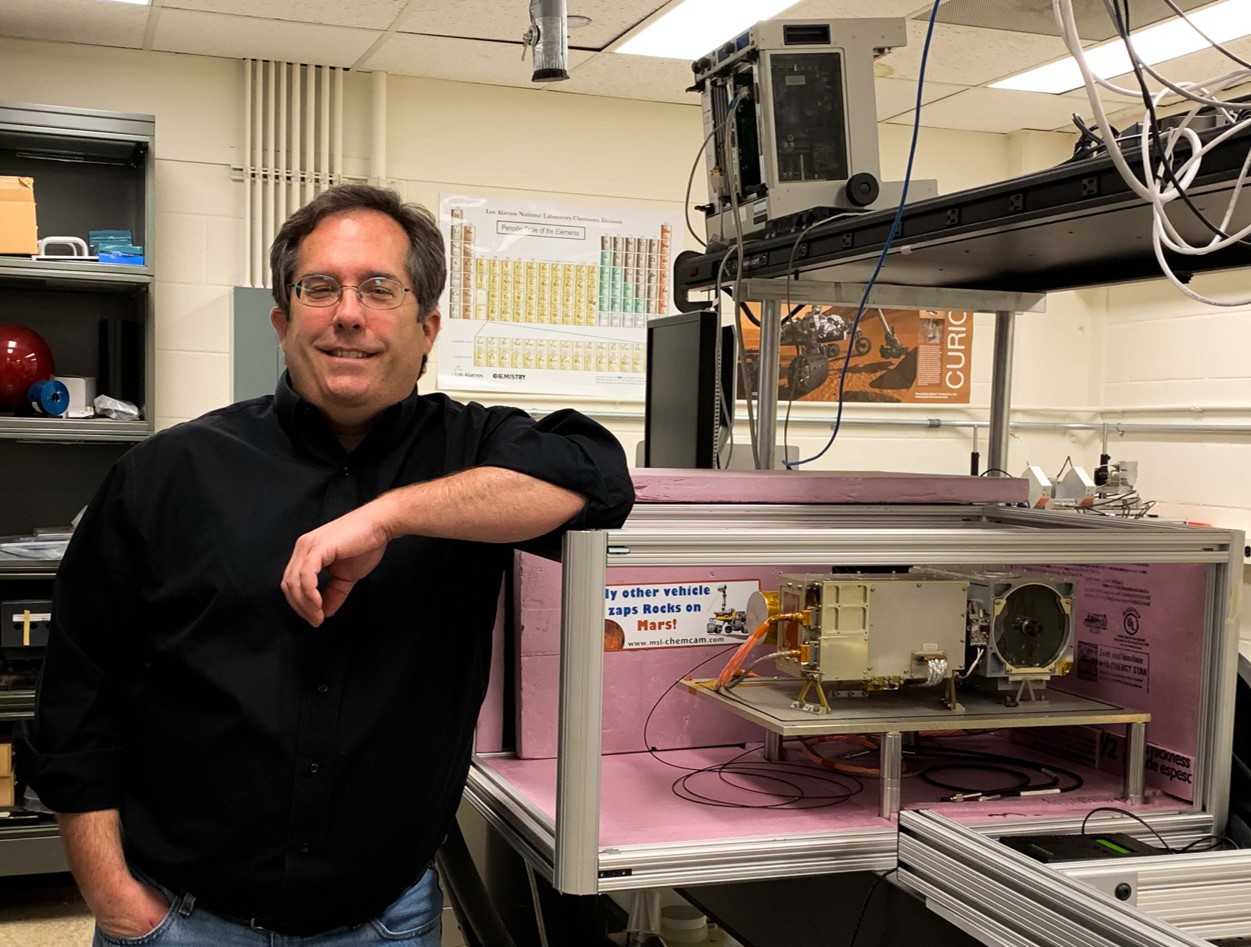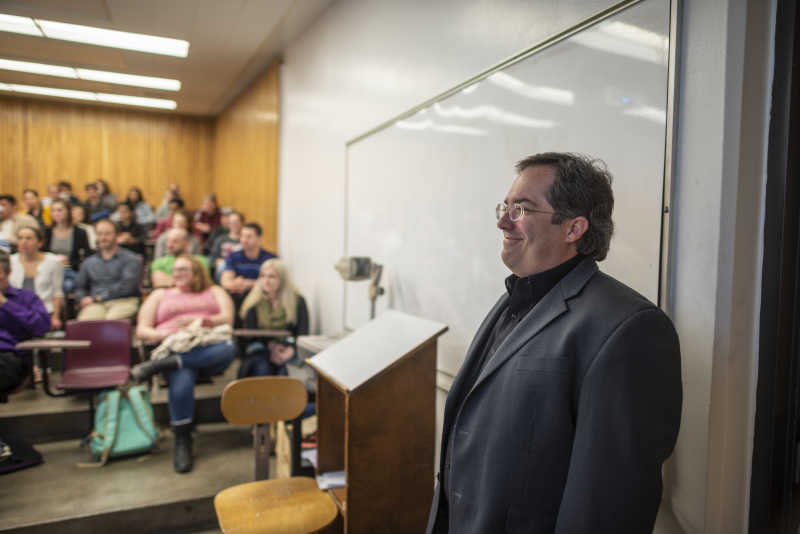Curiosity Fueled Alumnus’ Journey to Mars

Dr. Sam Clegg, a 1992 Chico State Alumnus from the Chemistry Department, is now a lead scientist on experiments on the Mars Curiosity Rover and the upcoming Mars 2020 Rover, who talks during a general public presentation on Friday, February 22, 2019 in Chico, Calif. (Jason Halley/University Photographer/CSU Chico)
As Curiosity Rover prepared its descent to the surface of Mars on August 5, 2012, the eyes of the world stared, marveling at history. Curiosity’s mission was to collect data, analyze soil samples, and capture images of the Martian surface never before seen.
Back on Earth, Sam Clegg contributed a play-by-play narration of the momentous landing to approximately 400 people who gathered to watch a broadcast of the event at Los Alamos National Laboratory’s Bradbury Science Museum.
“It was, at the time, what I believed to be a once-in-a-lifetime experience,” said Clegg, who also witnessed Curiosity’s launch at the Kennedy Space Center in Cape Canaveral, Florida in 2011. “I just tried to just soak in the experience and just really tried to enjoy it.”
Clegg (Chemistry, ’92), a laser spectroscopist and chemist at Los Alamos, served as a co-investigator and instrument developer for Curiosity on a team focused specifically on ChemCam, a chemistry and camera tool that used a laser, camera, and spectrograph to identify the chemical composition of soil and rock on the Martian surface. In the months after touching down, Curiosity would ultimately beam to Earth the clearest and most detailed images ever produced of the Red Planet.

(Photo courtesy of Sam Clegg)
In those first moments, though, Clegg enjoyed his role as storyteller, educating the public and media, and proudly shared the moment with his three children. Teaching, after all, is what he first thought he would do for his career.
The son of two Wildcat alums, he grew with a lifelong fascination with science and enrolled at Chico State with aspirations of becoming a high school science teacher.
The summer after his sophomore year, Clegg teamed up on a fluorescent spectroscopy research project with chemistry professor Randy Miller, who had just completed his first year teaching here. Clegg began to show boundless curiosity that primed him for a path well outside a classroom.
“Here’s a student who was excited about being in an instructional lab, tweaking things, fiddling around with things,” Miller recalled. “He always wanted to know, ‘why did we get the result we got, and how does that help us to design the next experiment we do?’ That’s where you want a developing scientist to be.”
For Clegg, the experience of mentor-led, hands-on research opened up an entirely new world and forever altered the course of his studies and his career.
“That experience with Randy changed everything for me,” he said. “It changed my whole perspective. My goals had changed.”
Instead of staying the course of becoming a teacher, Clegg was now focused on a career in research. The first stop was deepening his education. He earned his master’s degree in chemistry from San Jose State in 1994—while also working at NASA’s famed Ames Research Center—and then his PhD in chemistry from Indiana University in 1999.

(Photo courtesy of NASA/JPL-Caltech/MSSS)
After conducting postdoctoral research at the University of Chicago and at the renowned Sandia National Laboratory in Livermore, he spent little more than a year at Kirtland Air Force Base research lab in Albuquerque before landing at Los Alamos in 2003. Since then, all of Clegg’s research has involved the use of a laser, from measuring atmospheric stable isotopes and improving the effectiveness of laser-induced breakdown spectroscopy analysis to working side-by-side with ChemCam’s principal investigator, Roger Wiens.
When Clegg isn’t helping design the world’s most sophisticated equipment to study celestial bodies nearly 34 million miles from Earth, he takes time to speak to different groups about his work. His audiences can range from elementary school students and PhD-granting institutions to international conferences with the world’s brightest minds.
While he’s able to flex his science muscles more with expert audiences, Clegg still finds particular joy talking to younger crowds.
“We see calcium on Mars all the time. So, I’ll ask the kids, ‘What do you eat that has calcium? Milk and ice cream have calcium,’” he said. “I try to make that connection, I try to let them understand that what makes up Mars is exactly the same stuff that we have here.”
Clegg also returns to Chico State every few years to talk about his path to Los Alamos, projects he’s involved in, and tips for aspiring scientists, cultivated from nearly three decades of working at the nation’s top research facilities.
“Do well in your classes, get good grades, but also take the extra step,” Clegg said. “Find the faculty member that can give you that unique experience and help them prepare for whatever their future would become.”
On the horizon, Clegg is collaborating on the next spacecraft to explore the Red Planet. The Mars 2020 Rover will begin its eight-and-a-half-month journey in July 2020, touching down in Jezero Crater in February 2021.
Clegg is once again playing an important role as co-investigator on two Mars 2020 Rover projects—SuperCam, which Clegg said is “an upgraded version of ChemCam,” and SHERLOC, or the Scanning Habitable Environments with Raman and Luminescence for Organics and Chemicals. Using spectrometers and a laser and camera, SHERLOC will search for organics and minerals that have been altered by water—a marker that could indicate Mars once housed microbial life and create further discussion.

Jason Halley / University Photographer
“I suspect anything that we find on Mars that could indicate past microbial life will initiate significant discussions and I expect there will be many interpretations of such observations,” Clegg said. “This is why the Mars 2020 caching and sample return mission is critical for investigating any astrobiological observations made by SuperCam and SHERLOC.”
Clegg’s team is also in the early stages of developing VEMCAM (Venus Elemental and Mineralogical Camera) in hopes of one day sending an instrument like SuperCam to the surface of Venus.
While Clegg is part of a team that seeks answers about the origins and evolution of our solar system, the rewards are all around him. Living in the picturesque Jemez Mountains north of Santa Fe and Albuquerque, he’s in close proximity to an abundance of natural beauty, something Clegg and his family take advantage of when they can. And inside the walls of the storied Los Alamos National Laboratory, Clegg said there’s plenty to enjoy about his work.
“It’s filled with some of the most talented scientists and engineers I’ve ever met. The expertise here is incredibly broad,” he said. “If I had a challenge with something in particular, it’s more than likely that I could find an expert in that area someplace here at the laboratory.”
While the scientific world and public continue to peer up at the cosmos, wondering what secrets await discovery, Clegg also takes the time to look back.
“Where I am today, quite literally, started that summer after my sophomore year at Chico State,” Clegg said. “I had no idea this is where I’d be going, and it started back then.”


